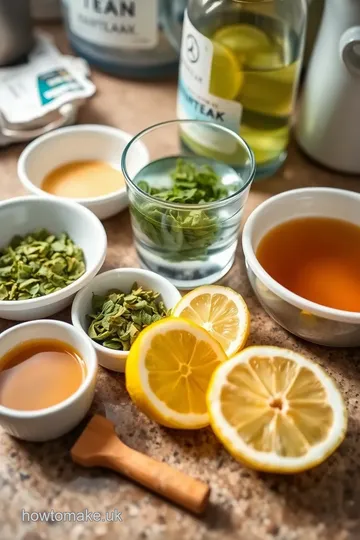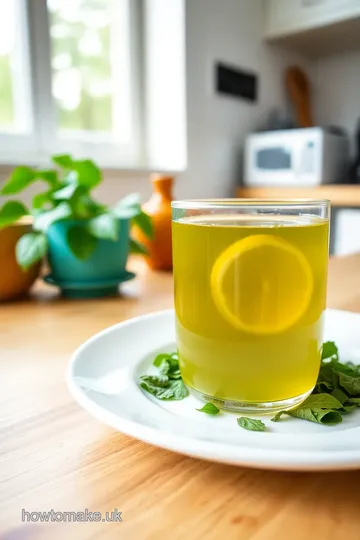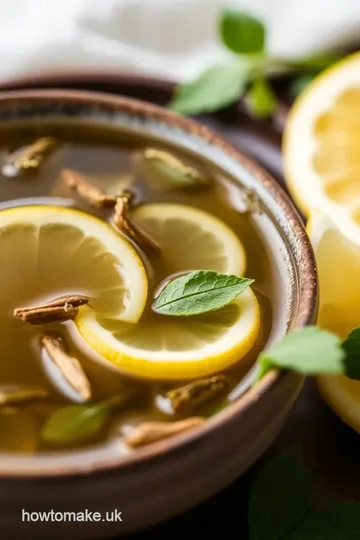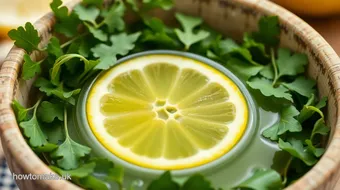How to make tea from ginkgo leaves: 7 Amazing Steps for Relaxation!
Looking to learn how to make tea from ginkgo leaves? Discover the health benefits of ginkgo tea and easy steeping tips for a delightful herbal infusion. Try it now!

- Secrets Behind Perfect Ginkgo Leaf Tea
- The Magic Behind This Recipe
- Health and Nutrition Highlights
- Recipe at a Glance
- Essential Components Guide
- Kitchen Equipment Essentials
- Foolproof Cooking Steps for Ginkgo Leaf Tea
- Master Chef's Advice
- Perfect Presentation
- Storage and Make-Ahead
- Creative Variations
- Complete Nutrition Guide
- Expert FAQ Solutions
- Recipe Card
Have you ever found yourself wondering what secrets lie within the leaves of our everyday flora? well, let me tell you, ginkgo leaves might just hold the answer! this delightful herbal tea isn’t just bursting with unique flavor; it’s steeped in history, brimming with potential health benefits, and oh-so-easy to whip up.
It only takes about 15 minutes to create two fragrant cups, and the best part? you don’t need a culinary degree—just some dried ginkgo leaves and water!
Ginkgo biloba, one of the oldest living tree species on earth, has a fascinating history that dates back over 200 million years! that’s right—this tree has survived ice ages, environmental changes, and even served as a living fossil.
Traditionally used in chinese medicine, the ginkgo leaves are cherished for their ability to enhance cognitive function and improve blood circulation.
Plus, their bold flavor adds a refreshing twist to herbal tea recipes.
Now, if you’re looking to dive into a tea that not only tastes good but also nourishes your body, ginkgo leaf tea is an absolute gem.
With unique selling points like its rich flavonoid content and calming properties, this tea isn’t just a drink; it’s a natural remedy that harks back to our ancestors' wisdom.
The simplicity of its preparation and its versatility in flavor make it the best herbal tea for adding to your wellness routine—as well as a proud addition to your kitchen repertoire!
Secrets Behind Perfect Ginkgo Leaf Tea
Let’s get into its culinary heritage, shall we? ginkgo leaves have been used for centuries in both cooking and herbal remedies.
Their charm lies not just in their flavor but their numerous ginkgo leaf health benefits. for instance, they’re renowned for improving memory and circulation—perfect for an afternoon pick-me-up!
Now, before we move on to the practical to-do's, let’s chat about the culture behind this tea. ginkgo trees hold a revered place in east asian culture.
Think about it: standing tall amidst bustling life, they serve as symbols of resilience and longevity. in modern times, ginkgo tea has climbed the ranks as a beloved drink, championed for its restorative properties.
Honestly, who doesn’t want to sip on something that connects them to centuries of wisdom?
The Magic Behind This Recipe
The magic of ginkgo leaf tea truly lies in its unique flavor combinations and expert-tested methods. there's something wonderfully soothing about its warm, herbal notes complemented by a touch of honey.
The sweetness balances perfectly, making it the ultimate cup of comfort. as for foolproof techniques, the key is controlling the steeping time.
Steeping for just 5 minutes gives you a lovely flavor without the bitterness that can come with over-steeping.
And, let’s not forget the time-saving tips! since this herbal infusion takes just minutes to prep and brew, it's a quick escape from your busy day.
Just imagine bringing a pot of this fragrant tea to your next gathering—your friends will surely be impressed!
Health and Nutrition Highlights
Now, let’s talk nutrition—ginkgo leaf tea isn’t just a pretty face! its health benefits are impressive, including antioxidant properties that help combat oxidative stress.
Plus, ginkgo’s flavonoids promote better blood flow and enhance cognitive function, which is perfect for busy bees like us. while everyone’s nutritional needs are different, this tea comfortably fits into most dietary considerations.
It’s a light beverage that provides balanced nutrition without the guilt—just 2 calories per cup!
Recipe at a Glance
- Total Preparation Time: 10 minutes
- Cooking Time: 5 minutes
- Total Time: 15 minutes
- Serving Size: 2 cups
- Difficulty Level: Easy
Now, here comes the exciting part—the ingredients!
If you’re itching to learn how to make tea from ginkgo leaves, gather the following ingredients:
- 2 tablespoons dried ginkgo leaves
- 2 cups water
- Honey or sweetener of choice (optional, to taste)
- Lemon slices (optional, for garnish)
Let’s get brewing! In the next section, I’ll guide you step-by-step through preparing your homemade herbal infusion. You'll be brewing your ginkgo tea variations in no time!

Essential Components Guide
You know how sometimes you wander into the kitchen with a glimmer of excitement, only to realize you're not quite prepared? that’s where this little essential components guide comes into play! it’s all about the ingredients you need, making sure you’ve got all the premium core components—and a few secrets up your sleeve—before diving into cooking (or in our case, tea brewing!).
Premium Core Ingredients
Let's chat about the good stuff. the foundation of any great recipe starts with quality. for our glorious ginkgo leaf tea, you'll need 2 tablespoons of dried ginkgo leaves and 2 cups of water.
Seems simple enough, right? but let's break that down a bit!
Detailed Measurements: For best results, follow those measurements closely. If you're feeling brave and want to experiment with fresh leaves, go for 4 tablespoons!
Quality indicators: ensure your ginkgo leaves are organic. that means they haven’t been blasted with pesticides, and you can sip your tea with confidence.
Look for rich green colors in fresh leaves or a vibrant earthy tone in dried.
Selection Tips: Always check the packaging. If it says “sun-dried” or “minimally processed,” you’re onto a winner. Fresh is always best, but you may need that time-saving dried version, and that’s perfectly fine!
Storage guidance: keep those leaves in an airtight container, away from the sunlight. if you can, go double-bag it for extra protection from moisture.
Dried leaves should last a good while if stored correctly—like a bottle of fine wine, just waiting for the right moment!
Signature Seasoning Blend
Ah, the magic of seasonings! While ginkgo leaf tea is a lovely standalone drink due to its health benefits—like promoting circulation—adding a touch of flavor can elevate your sipping experience.
Spice combinations: consider pairing your ginkgo tea with a pinch of ginger for warmth or a dash of cinnamon for that seasonal vibe.
If you're feeling adventurous, maybe a little cardamom could inspire a whole new recipe!
Herb Selections: You could mix ginkgo with chamomile for a relaxing brew or even mint for a refreshingly cool taste. Combining flavors is like creating your very own herbal symphony!
Flavor Enhancers: If you like a bit of sweetness, honey’s your friend. It's not just a sweetener; it adds a lovely layer of flavor that can soften any bitterness from over-steeping.
Aromatic Additions: Think lemon slices. They’re not just for garnish; they can brighten your tea and enhance the whole sipping experience. We love that little zing!
Smart Substitutions
Sometimes you're in the kitchen and realize you’re missing something—cue the panic! But fear not; I’ve got your back with these smart substitutions.
Alternative Options: Out of ginkgo leaves? No worries! You could use lemon balm or even dried chamomile in a pinch. Both bring their own unique soothing properties.
Dietary Swaps: If you're skipping sweetness for dietary reasons, go for stevia or even a splash of coconut milk for creaminess without the sugar.
Emergency Replacements: Out of fresh lemons? A splash of apple cider vinegar can work wonders in terms of acidity, though the flavor will skew a bit more tangy.
Seasonal Variations: In autumn, you could play with a bit of pumpkin spice! Just imagine your cozy ginkgo brew tasting like a fall dream!
Kitchen Equipment Essentials
Alright, let's talk gear. You don’t need some fancy-schmancy equipment to make great tea. Here’s what you'll need.
Must-Have Tools: A simple saucepan is your best bet. If you've got an electric kettle, that’s even cooler!
Recommended Appliances: If you’re serious about your tea game, consider investing in a good tea infuser. It lets those leaves dance freely in the water, bringing out all those delicious flavors.
Helpful Gadgets: A fine mesh strainer is a must-have if you're brewing loose leaves like dried ginkgo leaves. It helps catch all the bits that could ruin your sipping vibe.
Home Alternatives: In a rush and don’t have a strainer? A paper towel or clean cloth can double as a makeshift filter—just keep it clean and dry!
Pro Ingredient Tips
Now, let’s get into the nitty-gritty—because we all love a good insider tip!
Selection Secrets: Pay attention to your source! Go for a farmer’s market or trusted organic retailer for maximum flavor and nutrient retention.
Quality Markers: If you see vibrant colors or distinct smells, you’ve got freshness on your hands! Flowers should look intact and not crumbly.
Storage Solutions: Consider investing in some vintage glass jars to store your herbs—so chic and functional!
Money-Saving Tips: Buy in bulk. It might sound obvious, but you’ll save a pretty penny—and you’ll be well-stocked for your next tea party.
And there you have it! now, you’re all set to brew a cup of ginkgo leaf tea that will even impress your gran.
Now that you’ve got your ingredients sorted, let’s jump into the fun part—how to brew this lovely herbal infusion! happy sipping!
Foolproof Cooking Steps for Ginkgo Leaf Tea
Hey there! so, let’s have a little chat about a herbal gem i stumbled across recently: ginkgo leaf tea. i can’t believe i didn’t know about this sooner.
Honestly, it’s super simple to make, and it packs a punch with its health benefits. so, grab your kitchen gear, and let’s dive into how to make tea from ginkgo leaves.
I promise you’ll want to bottle this up and share it with everyone!
Essential Preparation Steps
Mise en Place Details
First off, let’s talk prep. for this ginkgo leaf tea, you’ll want to measure out your ingredients ahead of time.
Grab 2 tablespoons of dried ginkgo leaves and 2 cups of water. oh, and if you’re feeling fancy, some honey for sweetening and lemon slices for garnish never hurt anyone!
Prep Techniques
If you’re using fresh ginkgo leaves, make sure to wash them thoroughly and chop them up. you’ll need to double the amount to about 4 tablespoons.
A little tip from my kitchen experiments: it’s great to have everything laid out before jumping into the fun cooking part.
It cuts down on chaos… and possibly burns.
Time Management
You know, when i first started cooking, i was all over the place with timing and multitasking. now, i swear by timing everything.
For this tea, you’re looking at a prep time of about 10 minutes and a cooking time of 5 minutes.
So, in 15 minutes, you’ll have a soothing cup of tea.
Organization Tips
Keep your workspace tidy, because trust me, a cluttered kitchen can lead to a cluttered mind! have your measuring spoons, kettle, and cups ready to roll.
This way, when it’s tea time, you can just focus on sipping and savoring.
Professional Cooking Method
Now, let’s get into the tasty bits, shall we?
Step-by-Step Process
-
Boil the Water: You’ll want to start by bringing 2 cups of water to a rolling boil. I love that moment when the bubbles just start dancing around. It feels like magic!
-
Add ginkgo leaves: once it’s bubbling like a cauldron, change the heat to low and toss in your ginkgo leaves.
Give it a gentle stir; it’s like giving your leaves a little wake-up call.
-
Steeping: now, cover that pot and let the leaves steep for 5 minutes. if you’re one for bold flavors, you can let it steep a touch longer.
But beware—the longer you steep, the stronger it gets!
-
Strain the Tea: Once the time’s up, carefully strain the tea into your cups, discarding those leaves. I like to think of this as doing them a solid—they’ve done their job well!
-
Serve: here’s the fun part! if you’d like, add honey or your sweetener of choice. i sometimes go for a drizzle of honey—seriously, it enhances the flavor so well.
A slice of lemon on the side adds that extra zing!
-
Enjoy: Finally, curl up in your favorite chair and sip away. I always grab a good book for this part.
Temperature Control & Timing Precision
Keep an eye on that water; too hot can diminish the ginkgo’s beneficial compounds. A gentle heat maintaining that low boil is just what you want!
Expert Techniques
Now, we’re getting into the nitty-gritty!
Professional Methods
What I’ve realized is that using high-quality, organic ginkgo leaves makes all the difference. You want those leaves to really shine in your tea.
Critical Steps
Watch out for over-steeping! A bitter taste can ruin your cozy cup.
Precision Points
Taste it as you go. Maybe you fancy a stronger flavor or something lighter? Adjust your steeping time based on your flavor preference!
Quality Checks
Always go for the freshest leaves. If they’ve been sitting around too long, you might miss out on those yummy flavonoids and all the ginkgo leaf health benefits.
Success Strategies
So, if for some reason your tea doesn’t turn out as perfect as you’d hoped, don’t fret!
Troubleshooting Tips
If your tea’s too bitter, you likely over-steeped. Next time, cut that time down a notch.
Quality Assurance
Using common sense helps, too—if something doesn’t smell or look right, trust your instincts.
Perfect Results Guide
For the ultimate experience, try mixing ginkgo leaves with other herbs like chamomile or mint. The variations are endless, and you’ll keep finding new favorites!
Okay, now that you’re jazzed up about making ginkgo leaf tea, here’s a little teaser for the next section: we’ll dive deeper into the herbal magic of ginkgo leaves and explore some delightful variations! so stay tuned for more tips on how to brew herbal tea that not only tastes amazing but is also good for you.
Happy brewing and see you soon!

Master Chef's Advice
When it comes to brewing ginkgo leaf tea, surprisingly, you don't need to be gordon ramsay to make it shine—or to capitalize on those trendy health benefits.
Professional chefs will tell you that the best dishes often come from the simplicity of good ingredients and a dash of love.
For me, that means opting for high-quality, organic ginkgo leaves. you know, the fresher and cleaner your ingredients, the better your tea turns out.
Expert techniques for steeping tea—especially herbal types like ginkgo—emphasize temperature control. honestly, nobody wants a cuppa that's been boiled to oblivion! a low simmer is your friend here.
Let the leaves dance in the water for about five minutes, and you've got yourself a cup of liquid gold.
It’s like my grandma always said, “a watched pot never boils,” but once it’s boiling, that’s when the magic happens.
Perfect Presentation
Now, onto aesthetics! plating isn’t just for gourmet restaurant dishes—your cup of ginkgo tea deserves attention, too. use a cute teapot and matching cups to make serving feel special.
Simple garnishes like a slice of lemon or a sprig of fresh mint can elevate your cup from “blah” to “wow.
”
Honestly, that dash of color can liven up the table. imagine sitting down to enjoy your ginkgo leaf tea amidst lovely pastries or finger sandwiches for a cozy afternoon vibe.
Don't be shy about going the extra mile—after all, we feast with our eyes first, right?
Storage and Make-Ahead
Okay, this is the part where we get a bit practical. if you've got a stash of dried ginkgo leaves, proper storage is key.
Keep them in an airtight container, away from light, to preserve their integrity. i’ve learned the hard way that stale leaves just don’t cut it.
Now, if you want to prep your ginkgo infusion ahead of time, feel free to brew a larger batch and store it in the fridge.
Just remember that freshly made is always best; try to drink it within 2 days for the freshest flavor. and don’t you dare reheat it on high; a gentle warm-up in the microwave or on the stovetop is your best bet for keeping those lovely nutrients intact!
Creative Variations
The wonderful world of ginkgo leaf tea doesn’t stop at the basic brew! if you’ve ventured into herbal tea recipes, you might want to toss in some other herbs.
I’ve blended ginkgo with chamomile and peppermint for a calming twist—truly refreshing on a warm day! and speaking of warm days, have you tried cold brew ginkgo tea? toss those leaves in cold water and let them steep overnight for an easy, refreshing drink.
You can also play around with flavor enhancements. How about ginkgo tea with honey? Sweetening it up mellows out its natural earthiness. Talk about elevating an already nourishing beverage!
Complete Nutrition Guide
Now let’s dive into why you might want to sit down with a cup of ginkgo leaf tea. those ginkgo leaf health benefits are well-worth paying attention to! with flavonoids galore, ginkgo is loaded with antioxidant properties that are said to provide a myriad of health benefits.
You’re looking at potential boosts to brain function and cognitive health—big pluses, right? it’s like giving your brain a little pep talk in a teacup.
Plus, it’s incredibly low in calories, making it a guilt-free indulgence. just be mindful of how much honey or sweeteners you decide to add, as they can change the nutritional game a bit!
Expert FAQ Solutions
So maybe you're wondering, how to make tea from ginkgo leaves? just follow my step-by-step guide—easy peasy! but what if your tea tastes super bitter? don’t fret; that usually means the leaves were steeped for too long.
Experiment a bit with the time. sweetening it up can help salvage a batch, too!
Another common concern is storing that lovely tea once it's made. i always recommend using a cool, dry, airtight container.
It’s easy to love your brew but forget about it in the fridge. if you have any more curiosities or troubleshooting to dive into, don't hesitate to ask me—i've been there with my own culinary fails and successes!
In conclusion, whether you're in it for the ginkgo biloba benefits, crafting easy herbal infusions, or simply enjoying the relaxing nuances of this unique tea, the journey of brewing ginkgo leaf tea can be both delightful and nourishing.
Experiment, get creative, and most importantly, enjoy each sip of this herbal concoction you’ve lovingly crafted! happy brewing!

How to make tea from ginkgo leaves: 7 Amazing Steps for Relaxation! Card

⚖️ Ingredients:
- 2 tablespoons dried ginkgo leaves
- 2 cups water
- Honey or sweetener of choice (optional, to taste)
- Lemon slices (optional, for garnish)
🥄 Instructions:
- Step 1: Measure out 2 tablespoons of dried ginkgo leaves. If you are using fresh leaves, ensure they are thoroughly cleaned and chopped, using about twice the quantity (4 tablespoons).
- Step 2: In a saucepan or kettle, bring 2 cups of water to a rolling boil.
- Step 3: Once the water is boiling, reduce the heat to low. Add the dried ginkgo leaves to the water, stirring gently to help release the flavonoids and nutrients.
- Step 4: Cover the saucepan and let the leaves steep in the water for about 5 minutes.
- Step 5: After steeping, remove the saucepan from heat. Using a fine mesh strainer or a tea infuser, strain the tea into cups or a teapot, discarding the leaves.
- Step 6: Add honey or your preferred sweetener if desired. This is optional but can enhance the flavor of the tea. Garnish with lemon slices for a refreshing touch if desired.
- Step 7: Serve hot and enjoy your soothing cup of ginkgo leaf tea.
Previous Recipe: How to Make RSO with Coconut Oil: 5 Easy Tips for Delicious Infusions
Next Recipe: How to make a pumpkin cream chai latte: 5 Delicious Ways for Autumn Bliss
